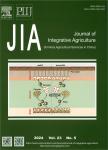High gene flows promote close genetic relationship among finewool sheep populations(Ovis aries) in China
High gene flows promote close genetic relationship among finewool sheep populations(Ovis aries) in China作者机构:Lanzhou Institute of Husbandry and Pharmaceutical Sciences Chinese Academy of Agricultural Sciences Lanzhou 730050 P. R. China Institute of Animal Science Chinese Academy of Agricultural Sciences Beijing 100193 P.R. China
出 版 物:《Journal of Integrative Agriculture》 (农业科学学报(英文版))
年 卷 期:2016年第15卷第4期
页 面:862-871页
核心收录:
基 金:sponsored by the Earmarked Fund for Modern China Wool & Cashmere Technology Research System (CARS-40-03) the National Natural Science Foundation for Young Scholars of China (31402057) Project support was provided by the ASTIP (Agricultural Science and Technology Innovation Program) for Genetic Resource and Breeding of Fine-Wool Sheep, Chinese Academy of Agricultural Sciences
主 题:Chinese fine-wool sheep indigenous sheep breeds genetic relationship gene flow microsatellites
摘 要:The aim of our present study was to construct genetic structure and relationships among Chinese fine-wool sheep breeds. 46 individuals from 25 breeds or strains were genotyped based on the Illumina Ovine 50K SNP array. Meanwhile, genetic variations among 482 individuals from 9 populations were genotyped with 10 microsatellites. In this study, we found high genetic polymorphisms for the microsatellites, while 7 loci in the Chinese superfine Merino strain (Xinjiang types) (CMS) and 5 loci in Gansu alpine superfine-wool sheep strain (GSS) groups were found deviated from Hardy-Weinberg equilibrium (HWE). Genetic drift FsT=0.019 (P〈0.001) and high gene flows were detected in all the 7 fine-wool sheep populations. Phylogenetic analysis showed fine-wool sheep populations were clustered in a group independent from the Chinese indigenous breeds such that the 7 fine-wool sheep clustered distinct from Liangshan semifine-wool sheep (LS) and Hu sheep (HY) reflected by different population differentiation analyses. Overall, our findings suggested that all fine-wool sheep populations have close genetic relationship, which is consistent with their breeding progress. These populations, therefore, can be regarded as open-breeding populations with high levels of gene flows. Furthermore, the two superfine-wool strains, viz., CMS and GSS, might be formed by strong artificial selection and with frequent introduction of Australian Merino. Our results can assist in breeding of superfine-wool sheep and provide guidance for the cultivation of new fine-wool sheep breeds with different breeding objectives.



